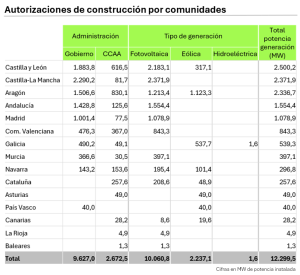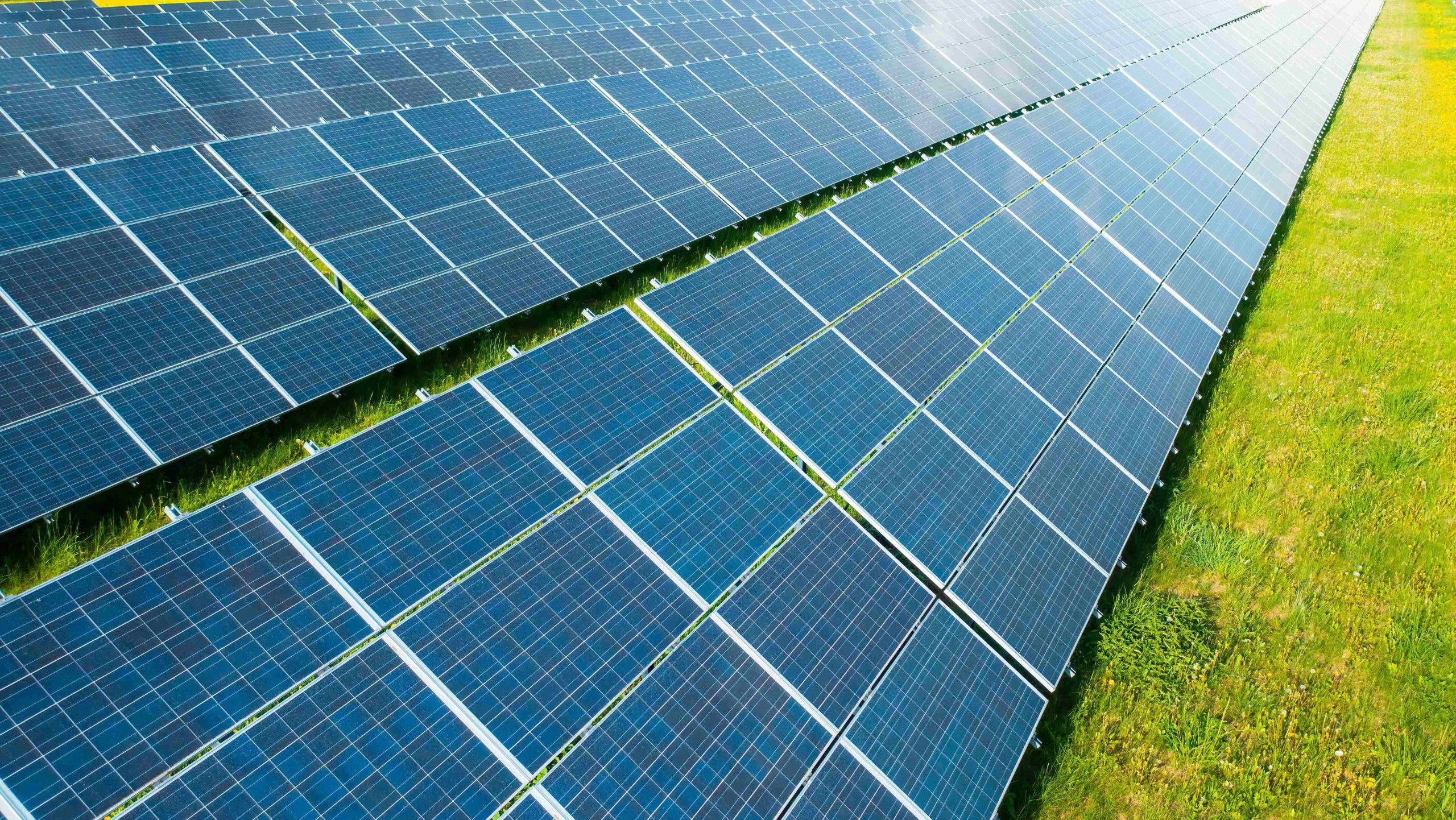
A total of 263 renewable energy projects, with an aggregated capacity of 12,299.5 MW, have received construction authorization during the third quarter of the year. This is highlighted in a report by the Renewable Energy Observatory of Foro Sella, prepared by Opina 360, which, for the first time, gathers data from both the Official State Gazette and the regional official journals.
The authorizations have been almost equally split between the Ministry for Ecological Transition (127) and the regional governments (136). However, the majority of the authorized capacity, 9,627 MW, belongs to projects processed by the central government, many of which were driven by the need to reach this milestone before July 25, according to the deadlines set by Royal Decree-law 23/2020. Meanwhile, the regional governments—responsible for installations with less than 50 MW installed capacity—have issued construction authorizations for 2,672.5 MW.
In terms of energy source, photovoltaic dominated the quarter, accounting for four out of every five authorized megawatts, with a total of 10,060.8 MW. Additionally, permits were granted for 2,237.1 MW of wind power and 1.6 MW of hydroelectric power.
From a regional perspective, three communities concentrated over half of the authorized capacity in this period: Castilla y León with 2,500.2 MW, Castilla-La Mancha with 2,371.9 MW, and Aragón with 2,336.7 MW. Following them is Andalusia with 1,554.4 MW. Madrid (1,078.9 MW) and the Valencian Community (843.3 MW) will also experience a significant boost in renewable generation once these projects are operational. Catalonia is also progressing, with construction authorization for 257.6 MW.
“The large communities that are already the main renewable energy producers in the country continue to advance at a fast pace, but we are starting to see that others, like Madrid, the Valencian Community, and Catalonia, are catching up,” says Juan Francisco Caro, director of Opina 360.
“Although all the projects have connection permits, one of the key factors now is that the transmission and distribution networks must grow in parallel to avoid bottlenecks. There is consensus in the sector on the need for more investment in networks to bring energy to the areas where demand exists. This is particularly important for regions like Catalonia to catch up with the leaders in renewables and meet both domestic and industrial renewable energy demand,” explains Caro.
Almost 2,000 MW with favorable environmental reports
Twenty-five projects progressed to an earlier phase in the third quarter, having achieved the milestone of obtaining prior administrative authorization. These projects total 422.1 MW, of which 379.1 MW correspond to photovoltaic plants and 43 MW to wind energy. Only one of these permits was processed by the Ministry for Ecological Transition (20 MW), while the rest were issued by regional administrations.
Furthermore, in the third quarter, environmental impact assessments with favorable outcomes were published for 70 projects, with a combined capacity of 1,975.6 MW. Photovoltaic energy accounted for 86.7% of the total generation capacity (1,716.1 MW). Regarding the responsible administrations, 57 of the reports were issued by regional governments, although these only represented just over half of the capacity that received environmental approval (1,107.3 MW).
Andalusia leads the regions with the highest volume of renewables with favorable environmental reports in the third quarter, with 799.1 MW. This is more than double that of the next region, Castilla y León, with 343.7 MW, followed by Murcia (274 MW), Catalonia (229 MW), and Castilla-La Mancha (125.8 MW).
More than 4,800 MW in the initiation phase
In terms of projects at the earliest stages, 201 renewable energy files were publicly disclosed during the third quarter, with a total generation capacity of 4,818.3 MW. More than four-fifths of that capacity (82.4%) corresponds to photovoltaic plants (3,972.5 MW), while the rest is from wind power projects (845.8 MW).
Among these, 57 projects, with a total capacity of 917.9 MW, are in their most initial phase, with applications for prior authorization. The remaining 144 projects, totaling 3,900.4 MW, have entered the public information phase to also obtain construction authorization and, in some cases, recognition of public utility status.
The vast majority of these renewable installations (168) fall under the jurisdiction of the regional governments. However, they account for less than half of the total capacity currently in the public information phase (2,133.2 MW, 44.3% of the total). The majority falls under the authority of the central government, through the Ministry for Ecological Transition.
Castilla-La Mancha emerged in the third quarter as the region with the highest volume of capacity in projects undergoing public information: 1,149.4 MW, all of which are photovoltaic and mostly processed by the central government. Aragón is in second place, with 868.9 MW, two-thirds of which are photovoltaic. Following them are other regions with significant renewable activity, such as Castilla y León (736.7 MW), Andalusia (666.2 MW), and the Valencian Community (572.1 MW), which is seeing a surge in new projects.
Unfavorable reports and rejections
Ten projects, with a total installed capacity of 673.6 MW, received unfavorable environmental reports during the third quarter of the year. On this occasion, the negative reports were concentrated almost exclusively in photovoltaic generation (620.6 MW).
The most affected regions were Madrid, with 379.5 MW rejected, and Castilla-La Mancha, with 161.1 MW. Projects were also discarded in Castilla y León (78 MW), Catalonia (30 MW), the Valencian Community (20 MW), and La Rioja (5 MW).
Ultimately, administrations declared the rejection of 26 renewable energy projects in the third quarter, with a total capacity of 1,404.5 MW. Most were rejected due to receiving unfavorable environmental reports, which led to the loss of connection permits.
The Ministry for Ecological Transition archived the largest amount of capacity, totaling 1,108.6 MW, compared to 295.9 MW by the regional governments. By energy source, 838.8 MW of rejected capacity was photovoltaic, while the remaining 565.7 MW was wind energy.
The regions most affected by these rejections in the third quarter were Aragón (with 742 MW of photovoltaic capacity) and Castilla-La Mancha (with 366.6 MW of wind energy). In both cases, the projects were dismissed by the Ministry. Regional governments also archived projects in six other regions.
610 MW of storage authorized
In addition, during the third quarter, construction authorization was granted for five storage projects, with a combined installed capacity of 610 MW. Nearly 94% of that capacity is concentrated in a single project, the reversible hydroelectric plant Navaleo, in León. The rest is distributed across the Basque Country (24 MW), Aragón (6.1 MW), the Canary Islands (4.5 MW), and the Balearic Islands (2.3 MW). Furthermore, prior authorization was granted for three storage facilities, with a total installed capacity of 20 MW—one located in Extremadura (10 MW) and two others in Navarra (10 MW).
At the public information phase, there are 26 storage projects, of which 23 are linked to new battery projects, while the rest are hybridized with photovoltaic parks. In total, these projects amount to 274 MW of installed capacity. Nearly 40% of this capacity is located in Castilla-La Mancha (108 MW).
Access to the full report.

